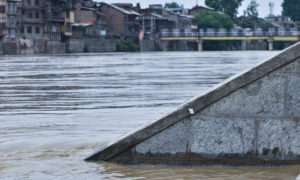New Delhi: Amid the ongoing debate over the Hindi movie The Kashmir Files, the former special director of the Intelligence Bureau and former chief of the Research and Analysis Wing (RAW), A S Dulat, said that returning to Srinagar in 1990 after an interval of four-to-five months came as a rude shock for Kashmir’s governor Jagmohan.
Jagmohan had been Jammu and Kashmir’s governor till August 1989 but when he returned the following January, the atmosphere had changed beyond recognition.
“The Kashmir that he came back to after four or five months, it was totally different from the Kashmir he had left. He was quite shaken himself,” The Telegraph reported quoting Dulat, who is considered one of the country’s foremost experts on Kashmir and the insurgency.
As per the report, The Kashmir Files, has stirred polarising memories of those times. Dulat hasn’t seen the movie and he doesn’t intend to. “I don’t see propaganda. And it is a propaganda movie,” the report quoted him as saying.
Jagmohan had been reappointed as governor when the V P Singh government came to power. In December 1989, Home Minister of India Mufti Mohammad Sayeed’s daughter Rubaiya Sayeed had been kidnapped and in exchange for her release, five militants had been freed.
That changed the atmosphere in Kashmir overnight, says Dulat, who was the Intelligence Bureau station chief in Kashmir at the time.
Overnight, many youngsters were convinced that independence for the state was just round the corner. “There were celebrations in Srinagar like it was Diwali,” he said, as per The Telegraph.
When the Kashmiri pandits started migrating, the Dulat said, Jagmohan was quite relieved. “When these killings started, he didn’t want the pandits to bear the brunt of it. So once they started leaving, he was quite happy,” he said.
Quoting the former Raw chief, the report said, “It was a natural reaction. If they are leaving, ‘Good.’ There was no way that we could provide any protection to them because things were so bad.”
Dulat still remembers Kashmir which was a relatively peaceful place till the kidnapping. “Everything changed overnight. Till then, we used to move out freely in the city. I also traveled all over the state. But after the five people were released, everything went out of control and there was a lot of bloodshed,” he says.
“I was there when it all began. It was pretty nasty times, you know, that winter of 1989-90,” Dulat recalls.
In the months that followed the killings, the death toll shot through the roof. In May 1990, armed assassins barged into the home of Mirwaiz Maulvi Mohammad Farooq and shot him dead. Then came a string of targeted killings, including four of Dulat’s own IB team – killed within a space of just three weeks. militants also killed members of the JK police special branch. “It went from bad to worse,” he was quoted further saying.
This was a total contrast to before the Rubaiya kidnapping. One Kashmiri pandit who had been killed before the kidnapping was Judge Neelkanth Ganjoo who had presided over the Maqbool Bhat trial. Another BJP lawyer had also been killed.
“There’s no doubt about it that pandits were targeted. Like a lot of other people were targeted. And Muslims were targeted, very much so,” Dulat says.
The pandit migration, says Dulat, began soon after the killings in 1990. The more affluent in the community headed for Delhi and ones who had nowhere else to go went to camps that had been set up in Jammu. “After Rubaiya’s kidnapping and the release of the (JLFK) guys and the new mood in the Valley, then the pandits felt more insecure and more of them left.
Quoting Dulat further, the report said the Kashmiri Muslims who could afford it also left for destinations like Delhi. They returned when the situation seemed to get better. “Many more Muslims than pandits left – a large number. A lot were killed,” he said.
Dulat says that many pandits who chose to stay behind were “protected by Muslims”. And he says that pandits did stay back. He adds: “Even after the abrogation of Article 370, the pandits have not been targeted.”
The numbers of people killed and who fled quoted in The Kashmir Files have come in for considerable criticism.
A reply to a Right to Information query last December said that 1,724 people had been “killed by militants” in Kashmir totally “since the inception of (the) militancy (in) 1990,” out of which 89 were Kashmiri pandits.
The reply came from a DSP in Srinagar. Dulat underlines that the large numbers of pandits began leaving soon after the 1990 killings and headed for safer regions. “The first Kashmiri pandit to be targeted was I think in September 1989,” he said, as per the report.
But Dulat does deplore the fact that very little was done for the pandits. And very few have felt safe enough to return to Kashmir.
“Government after government has paid lip service to the idea of bringing the pandits back but it has not happened.” The RTI reply in December pointed out that pandits who registered were given a monthly sum of money and free rations.
Would it really be possible for the pandits to return to Kashmir? Dulat feels that if they went back, their neighbours and friends would try to protect them. But he says that building separate colonies for them would be entirely the wrong way to go about it. “If you built a separate colony for them, they would be targeted,” the report quoted him further saying.
Free Press Kashmir is now on Telegram. Click here to Join.
FPK Android App for 2G. Click here to Download.








